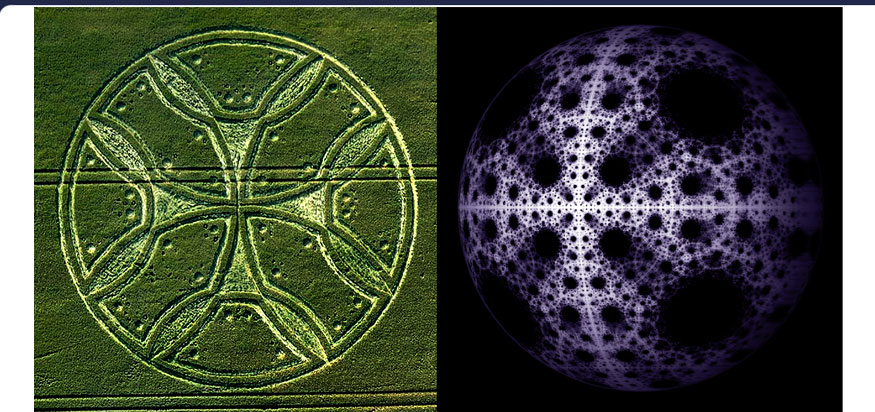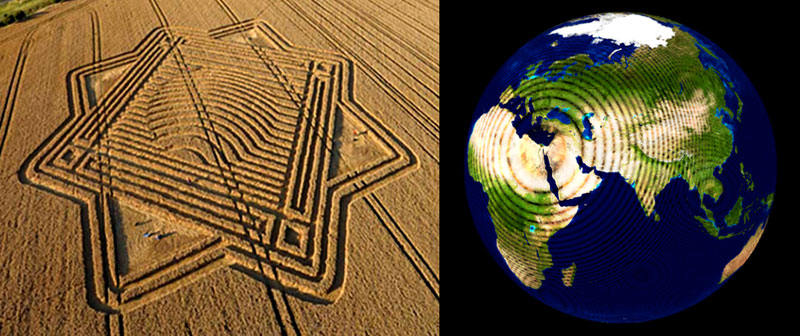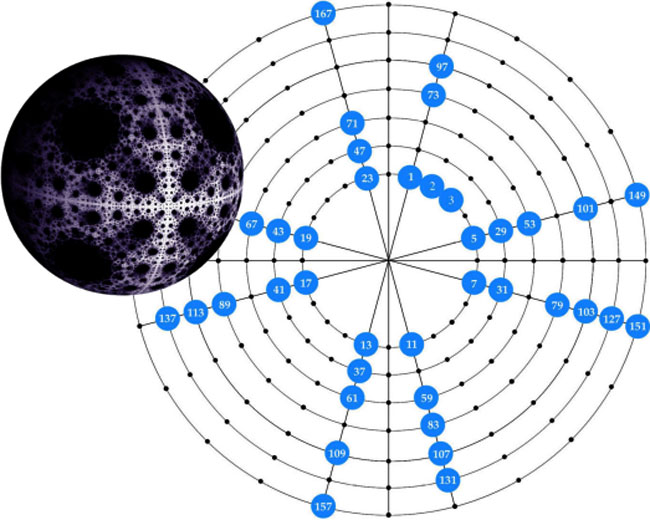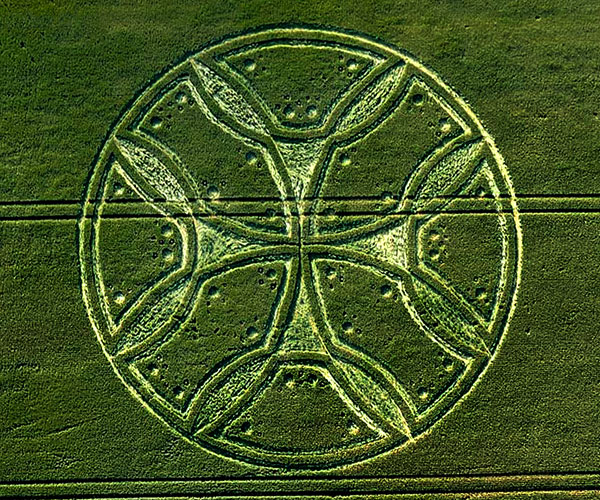




Mandala Formation in Westwoods, England
Westwoods Crop Formation Reiterates the Prime Cross Formula for Magnetic Resonance
by Alex Putney for Human-Resonance.org
June 21, 2011
Another spectacular crop formation -this time reported in Westwoods, England on June 21, 2011- has rendered the sacred cross symbol known among many ancient cultures, variously called the Kalachakra, the Circle of the Four-Quarters, Hunab K'u, the Celtic Cross, the Rose Cross, etc... This beautiful formation is a simplified 2-dimensional image in living grains that references a higher-dimensional structure of cosmic resonance - refered to among the ancient Sanskrit traditons as the seed syllable 'OM'.
In studying this sacred symbol within the ancient cultural context, I had understood it as reflecting the global geometry of infrasound standing waves that are transduced by the axis-symmetric geometry of the Orion pyramids of Giza, Egypt. I had been rendering spherical mandalas using the 2-dimensional algorithms of mathematicians and physicists like P. Bourke and A. Jadzyck and produced a spherical Prime Cross quantum function rendering (above, at right) in 2004.
The spherical Prime Cross rendering bears a striking resemblance to the Westwoods crop circle (compared above), and provides a profound conformation of my applcations of this mathematics to the study of spherical resonance patterns. The nonlinear physics of standing waves reveals this mandala formula as encoding the global infrasound pattern of Magnetic Resonance that defines the precise geopositioning of the world's pyramids, megaliths and sacred sites.
Westwoods, England (51.39°N 1.76°W) is 2,240 miles from Giza, Egypt, a distance that is 9.0% of the Earth's mean circumference (of 24,892 miles). This sacred distance is shared by the nearby megalithic site of Stonehenge. Another mandala crop formation that appeared in England in 2010, at Whitefield, presented the similar nonlinear octagonal formula [ zn+1 = zn2 ]:

This geometric formula previously appeared in the fields on Lurkley Hill, in Lockeridge, England, and then again in nearby Wayland-Smithy. It is a fractal equation closely related to the Mandelbrot Set, [ zn+1 = zn2 + c ]. First rendered by French mathematician Benoit Mandelbrot in 1980, this formula appeared in 1991 in the wheat fields of Ickleton, England.
The multitude of standing wave resonance maps presented throughout this site were rendered using these sacred formulas, which are keys to the nature of human consciousness and the changes culminating in the coming events of December 22, 2012. The revelation of the structure of the electron is but one in a series of profound discoveries that will altogether transform the human experience on this planet.
I had originally published the Prime Cross rendering in my first book Phi and on this homepage in 2006, and was republished by the Natural World Museum in Art in Action: Nature, Creativity and Our Collective Future (Earth Aware Editions, 2007, ISBN: 978-1-932771-77-0). Here is an excerpt of my 2006 writings on the subject of the Prime Cross (Phi, p. 128-130):
This octagonal cross was once called the Celtic Cross, the Rose Cross by the Copts (as engraved at the Temple of Philae and painted on ceramics, above), and is referred to by Native American tribes as the four-quartered hoop of the nation -a complex structure referenced by prime number geometries encoded in myriad artifacts from La Maná, Ecuador. In their collective presentation of the sacred order of primes, the deeper holographic application of the information comes into focus.
Prime numbers are defined as numbers that are only divisible by 1 (and by themselves). The organization of prime numbers within the series of whole numbers has been a mystery to modern mathematics until the work of Peter Plichta, a Düsseldorf chemist. In 1997 he put forth his theory of the structure of prime numbers being based on a cycle of 6, a product of the indivisible numbers 1, 2, and 3. While not the first mathematician to recognize the six-cycle of the sequence of primes, his work has extended this understanding to the role of prime numbers in all of the structures underlying the physical universe:

Apart from the numbers 2 and 3, all prime numbers occur in a cycle of 6. 6 n ±1 for n = 1, 2, 3, 4, .... For combination reasons this cycle produces a series of prime-number twins, [5, 7], [11, 13], [17, 19], 23, .... although with the number 25 we inevitably obtain the first square of a prime number from the function 6 n ±1 (the next composite number is the product of 5 x 7 = 35), which is not prime. The reason why the number six plays such an elementary role in the complex of whole numbers is that the numbers 1, 2 and 3 are indivisible. As a result, the complete number 6 must be surrounded by the expression: 6 - 1 = 5 and 6 + 1 = 7...
Plichta's search for the significance of prime numbers extends to the essential structures of nuclear chemistry and biochemistry, specifically that of atoms and the periodic table of elements, as well as the amino acids and the DNA helix. The six-cycle structure of prime numbers can be visualized as a symmetric octagonal cross, with seven concentric circles divided into 24 radial points (above). Being a universal constant, Plichta observes that "the 'Prime Number Cross' is not a human invention. It is in fact a model of the construction plan with which infinity was made finite in the structure of the atoms."
This same model has also been derived by the quantum mechanical algorithms of theoretical physicist Arkadiusz Jadczyk in a more complex rendering known as the Octagonal Quantum Iterated Function (QIF) (above, inset). The Prime Number Cross and the Octagonal QIF are synchronous patterns reflecting the structure of resonance inherent to atomic, molecular, planetary, solar and galactic structures.
